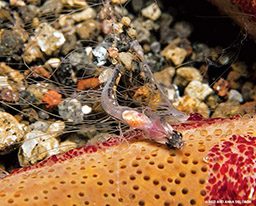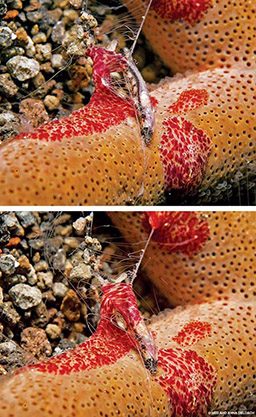Anyone else would swim right past the nickel-sized layers of life pasted to the arms of a sea star easing its way along the sand slope. But not Anna. Strange little creatures always catch her eye.
Motioning me over, she points out what appear to be flatworms until she directs my attention to wisps of filaments streaming from openings on their red and white backs — a sure giveaway that these are not flatworms. Interesting, I admit, but the waters around Bali teem with unfamiliar, understudied and, all too often, unappreciated animals. And besides, at the moment I have my heart set on finding a blue-ringed octopus that was sighted nearby the morning before. With a shrug I head off to join our guide, leaving Anna kneeling on the bottom, communing with her latest infatuation, which turns out to be benthic ctenophores.

Ctenophora (the “c” is silent) is a small phylum of ancient origin. Its members, commonly known as comb jellies, are primarily fragile, ocean-going organisms that are easily confused with jellyfishes. The archetypal ctenophore is a translucent, walnut-shaped structure with eight rows of ciliated cells that beat in unison to paddle it about and a pair of long, retractable feeding tentacles bearing a curtain of side branches lined with adhesive cells. On a good day a ctenophore’s sticky net can ensnare 10 times its weight in microscopic zooplankton (most commonly larval crustaceans).
Ctenophores date back to the beginnings of multicellular organisms, but exactly how far back is the subject of a long-running debate. For decades their phylum was traditionally placed third on the early tree of life behind sponges and cnidarians (corals, jellyfishes and their kin). However, a 580-million-year-old fossil recently unearthed in China as well as early sequencing results of the ctenophore genome offer enticing evidence for revising the age of Ctenophora and placing them before Cnidaria — no small move in the arcane world of evolutionary biology.
Through the ages, ctenophores’ simple sea-going structure has served them well. To this day the phylum’s members remain prominent fixtures in the ocean’s pelagic community. But at some point in the past 66 million years a few species got tired of their wandering ways and plastered themselves like dollops of glue to an assortment of bottom-dwelling organisms. No longer necessary for propulsion, their eight comb rows disappeared, but the feeding tentacles remained, gathering tiny bits of food from their surroundings like their oceanic ancestors. Or so it seemed.

Obsessed with the little-known, poorly studied creatures, Anna searches for benthic ctenophores everywhere we dive in the Pacific, commandeering guides, friends and shipmates in her quest. Using a search image of billowing tentacles, she finds ctenophores attached to soft corals, gorgonians and algae and even a few solitary types living directly on the open sand. But the species that fascinates her most remains Coeloplana astericola, the multicolored beauties found on the roving sea stars in Bali and the only species that attaches to a mobile host. Being hauled around the bottom by a sea star must offer some evolutionary advantage in the struggle for life, but exactly what is anyone’s guess.
Diving off the Indonesian island of Halmahera a year or so after the Bali affair, Anna makes another of her grand little discoveries. She waits until we’re all back on the liveaboard and sitting down to a lunch of noodles before springing her news. With a final shake of soy sauce she begins: “You know those dainty little plankton-nibbling ctenophores living on sea stars I’m forever trying to get you to photograph for me? Well, guess what? I saw one devour a fish this morning. Yanked it right off the bottom and engulfed it whole. Everything happened fast. You should see it.”
On the next dive I bail out of our skiff near the shallows where Anna observed her nomadic constellation of ctenophore-adorned sea stars, but they are nowhere to be found. We finally track down the group some 50 meters away — quite a journey, even for animals with a thousand tube feet. Several of the sea stars, wallpapered toe-to-toe with ctenophores, creep along beneath a glistening vail of tacky tentacles. “If anything can catch a fish it’s this crowd,” I’m thinking as I settle in to see what happens.
The wait isn’t long. As the sea stars cross the bottom, little buried fish in their path, known as sandburrowers, pop out of the sand like popcorn. In no time at all one of the ctenophores entangles a sandburrower twice its size, reels it in and rolls it up pretty as a Cuban cigar.
© Alert Diver — Q2 Spring 2015